The legal system is split into two main parts: civil law and criminal law. Civil law handles disputes between individuals, while criminal law deals with crimes against the state or federal government. It’s important to know the differences between these systems to understand the law better.
Civil law and criminal law have their own rules and outcomes. In civil cases, the winner must prove their point by more than 50%. But in criminal cases, the state must prove guilt with over 95% certainty.

Knowing the difference between civil and criminal law is key. Civil cases usually find someone liable, while criminal cases find someone guilty. Civil cases might award money for damages, while criminal cases can lead to fines or jail time.
Key Takeaways
- Civil law deals with disputes between private parties.
- Criminal law involves crimes against the state or federal government.
- The burden of proof in civil cases is based on the preponderance of evidence.
- The burden of proof in criminal cases requires proving guilt beyond a reasonable doubt.
- Civil law cases often result in findings of liability, while criminal cases result in guilty verdicts.
- Remedies in civil cases may include compensation for injuries or damages.
Understanding Legal Systems Basics
Legal systems are key to a society working well. They help solve disputes and punish wrongdoers. At their heart, legal systems have legal categories that outline the law’s scope and historical development.
The law definition is vital to grasp legal systems. It helps tell apart different laws and their uses. Laws mainly fall into civil and criminal categories. Civil law handles disputes between people or groups, aiming to compensate victims. Criminal law deals with serious crimes like theft, assault, and murder, aiming to punish and protect society.

- Civil law: focuses on disputes between individuals or organizations, with the goal of providing compensation to victims.
- Criminal law: encompasses offenses such as theft, assault, and murder, with the goal of punishing wrongdoing and protecting society.
- Historical development: legal systems have evolved over time, with different societies and cultures developing their own unique systems and traditions.
| Legal Category | Description |
|---|---|
| Civil Law | Deals with disputes between individuals or organizations |
| Criminal Law | Encompasses offenses such as theft, assault, and murder |
What is Civil Law?
Civil law, or non-criminal law, deals with disputes between private citizens. It usually involves money or property issues. Cornell Law School says civil law covers all non-criminal cases, making it key to the legal system. Civil law helps solve private disputes, like contract problems, property issues, and family law.
Some important areas where civil law is used include:
- Contract disputes, such as breach of contract or negligence
- Property issues, including eviction, foreclosure, or property damage
- Family law matters, such as divorce, child custody, or adoption
Civil law helps solve these disputes fairly and orderly. Knowing civil law helps people understand the legal system better. Cornell Law School says civil law is vital, affecting both individuals and society.

In civil law, the evidence needed is lower than in criminal cases. The plaintiff must show their claim is more likely true than not. In criminal cases, the prosecution must prove guilt beyond a reasonable doubt.
What is Criminal Law?
Criminal law is a set of rules that punishes or helps change those who break the law. The Princeton Review says it deals with crimes like violence and damage to property. Its main goal is to punish and change offenders, keeping society safe.
This law covers many types of wrongdoings, from small mistakes to big crimes. It includes defining crimes, investigating and prosecuting them, and punishing offenders. Common crimes include murder, theft, and robbery.
In short, criminal law is key to keeping society in order and protecting its people. It punishes and changes wrongdoers, aiming to stop future crimes and make society safer and fairer.
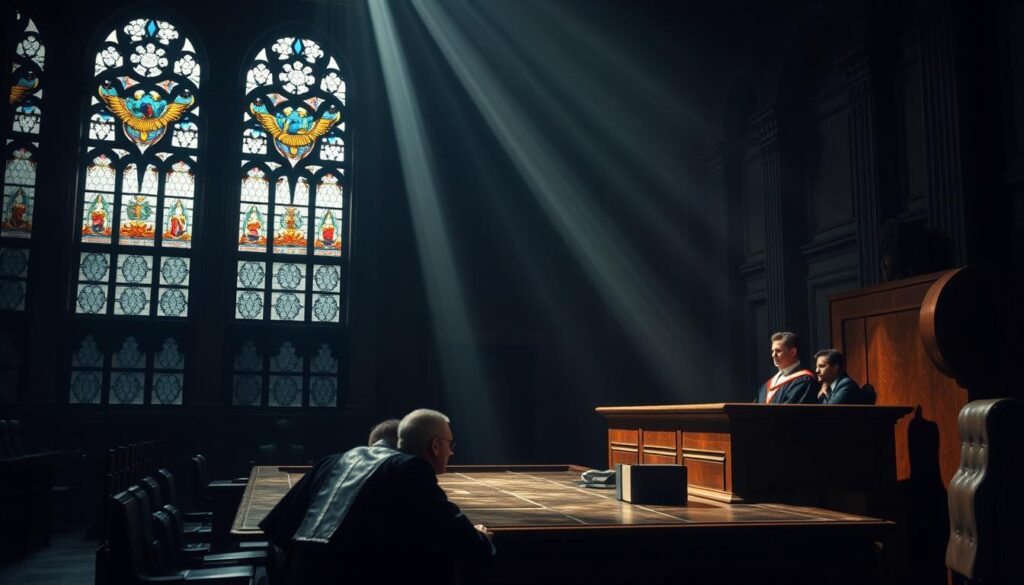
Key Difference between Civil Law and Criminal Law
The main difference between civil law and criminal law is their purpose. Civil law helps solve disputes between people or groups, like when a contract is broken. Criminal law, on the other hand, deals with breaking laws, like theft or murder.
In civil law, it’s usually individuals or groups fighting each other. But in criminal law, the state is the one bringing charges. The rules for proving a case are different too. Civil law needs just enough evidence, while criminal law requires strong proof.
Purpose and Intent
Civil law aims to give money or other help to those who were wronged. Criminal law wants to punish the wrongdoer and keep society safe.
Parties Involved
In civil cases, it’s the person suing (the plaintiff) against the one being sued (the defendant). But in criminal cases, it’s the state against the accused.
Burden of Proof
The rules for proving a case are different in civil and criminal law. In civil cases, the person suing just needs to show they’re right. But in criminal cases, the state must prove the defendant is guilty without any doubt.
| Type of Law | Purpose | Parties Involved | Burden of Proof |
|---|---|---|---|
| Civil Law | Resolve disputes, provide compensation | Private individuals or organizations | Preponderance of the evidence |
| Criminal Law | Punish offenders, protect society | The state and the defendant | Proof beyond a reasonable doubt |
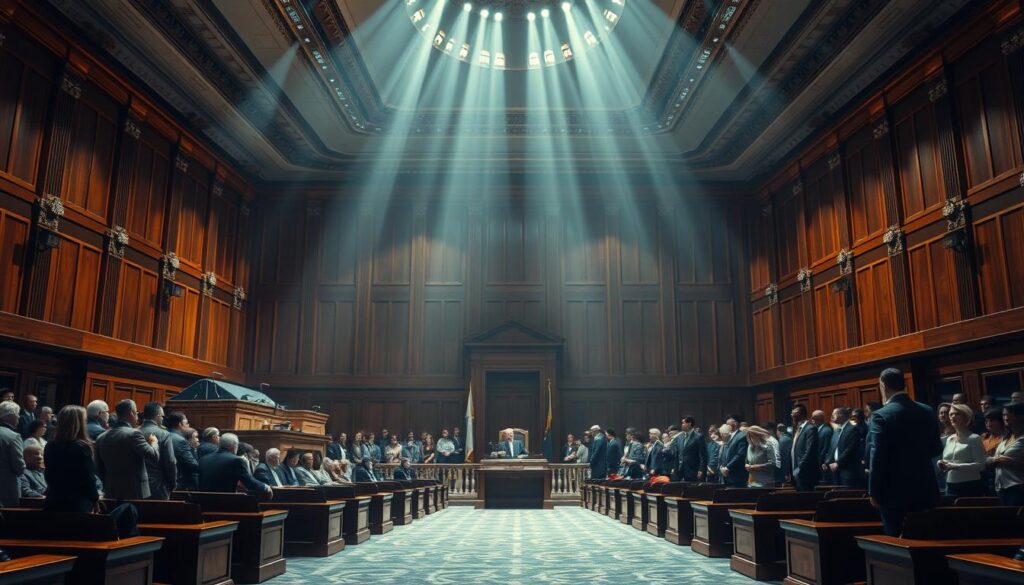
Types of Civil Cases
Civil cases fall into several categories. These include contract law, property law, family law, and tort law. These disputes can happen between people, groups, or the government. They often lead to money being paid out or other forms of relief.
In contract law, issues might come up over a contract’s terms. Property law cases deal with who owns what, where property lines are, or how property is used. Family law cases involve things like divorce, who gets custody of kids, and child support.
Here are some examples of civil cases:
- Disputes over contract terms or payment
- Issues with property ownership, eviction, or foreclosure
- Family law matters like divorce or child custody
- Tort law cases, like personal injury or medical malpractice
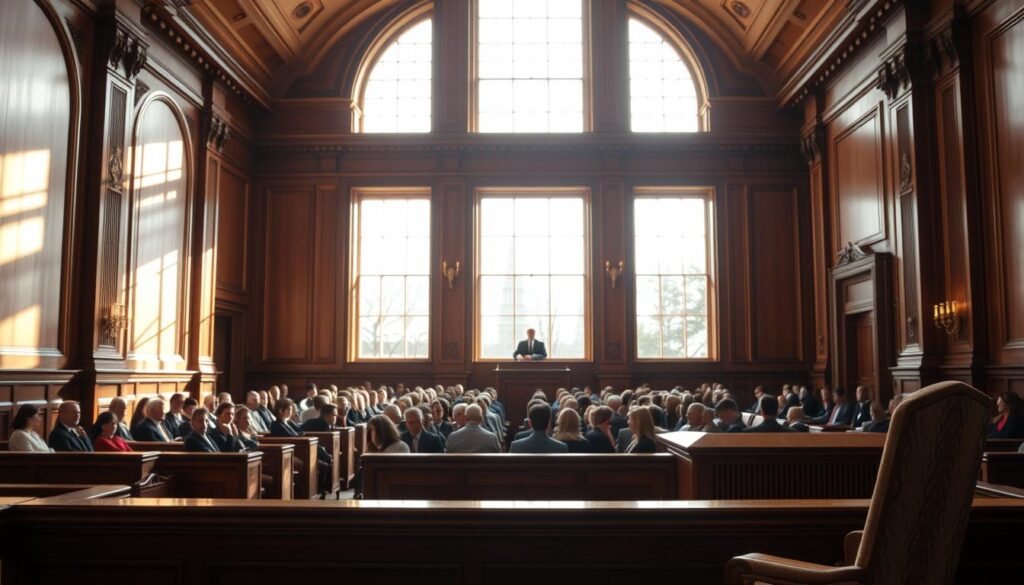
Civil cases can be complex and take a lot of time. They often need a skilled lawyer. The Legal Aid Society of Northeastern New York helps with civil cases. This includes issues with domestic violence, family law, and housing.
| Type of Civil Case | Description |
|---|---|
| Contract Law | Disputes over contract terms or breach of contract |
| Property Law | Disputes over property ownership, boundaries, or usage |
| Family Law | Disputes over divorce, child custody, or child support |
| Tort Law | Personal injury or medical malpractice claims |
Common Criminal Offenses
Criminal offenses are divided into felonies, misdemeanors, and infractions. These categories show how serious a crime is and what punishment it might get. Felonies are the worst, leading to big fines and jail time. Misdemeanors are less serious, with penalties like jail, fines, or losing rights.
Common crimes include murder, assault, and drug possession. The level of these crimes can change based on where you are. Some places use letters to show how serious a crime is.
Types of Criminal Offenses
- Felonies: include selling or manufacturing illicit drugs, arson, kidnapping, aggravated assault, and murder
- Misdemeanors: include disorderly conduct, petty drug crimes, trespassing, public intoxication, and parking tickets
- Infractions: typically include minor offenses such as traffic violations or noise disturbances

In court, the prosecutor must prove a case “beyond a reasonable doubt.” Knowing about different crimes and their levels is key to understanding criminal law.
| Type of Offense | Examples | Potential Punishment |
|---|---|---|
| Felony | Selling or manufacturing illicit drugs, arson | Imprisonment, significant fines |
| Misdemeanor | Disorderly conduct, petty drug crimes | Jail time, fines, loss of privileges |
| Infraction | Traffic violations, noise disturbances | Fines, community service |
Legal Procedures in Civil Cases
In civil court, one person sues another due to a disagreement. This is explained by The Legal Aid Society of Northeastern New York. The civil case procedures include steps from filing to discovery and settlement options.
Filing Process
The process starts when the plaintiff files a complaint with the court. This complaint outlines the dispute and what they want. The defendant then gets a summons and a copy of the complaint. They must respond within a set time.
Discovery Phase
In the discovery phase, both sides share information and evidence. This includes witness statements, documents, and other important materials.
Settlement Options
Before going to trial, the parties might try to settle. They can use mediation or arbitration to find an agreement. This can save time and money compared to a trial.
Here is a summary of the civil case procedures:
| Step | Description |
|---|---|
| Filing | Plaintiff submits complaint to court |
| Discovery | Parties exchange information and evidence |
| Settlement | Parties negotiate a mutually acceptable agreement |

Criminal Court Procedures
In a criminal court, the government accuses someone of a crime. They must prove the defendant is guilty beyond a doubt. This means they need to be almost 100% sure.
The prosecution is key in showing evidence and arguing the case. They try to prove the defendant is guilty.
The criminal court goes through several steps. These include filing charges, preliminary hearings, and the trial. At the trial, the prosecution shares their evidence. The defense then gets to say their side.
The court then decides if the defendant is guilty or not. They look at all the evidence.

- The burden of proof: The government must prove the defendant’s guilt beyond a reasonable doubt.
- The role of the prosecution: The prosecution presents the case against the defendant and argues for a conviction.
- The role of the defense: The defense presents the case for the defendant and argues for an acquittal.
In criminal court, the penalties for being found guilty can be harsh. The court can sentence someone to jail or prison. The length of the sentence depends on the crime and the defendant’s past.
Knowing how criminal court works is important. It helps people understand the complex world of criminal law.
Burden of Proof Requirements
The burden of proof is key in both civil and criminal cases. It shows how strong a claim or accusation must be. In civil cases, the standard is lower. It only needs a preponderance of evidence, meaning the claim is more likely true than false.
At Cornell Law School, this means the claim is true with more than a 51% chance. This is the standard for civil cases.
Criminal cases, on the other hand, have a much higher standard. They need proof beyond a reasonable doubt. This is a much higher bar than in civil cases. The prosecution must be at least 95% sure of the defendant’s guilt.
Civil Case Standards
In civil cases, the plaintiff must show over 50% certainty. This means their claim is more likely true than false. But it doesn’t need to be 100% certain.
Criminal Case Standards
In criminal cases, the prosecution must prove guilt beyond a reasonable doubt. This high standard is to protect the accused. It ensures only those truly guilty are convicted.
The consequences of a criminal conviction are severe. They include imprisonment and loss of freedom. This makes the burden of proof in criminal cases much higher.
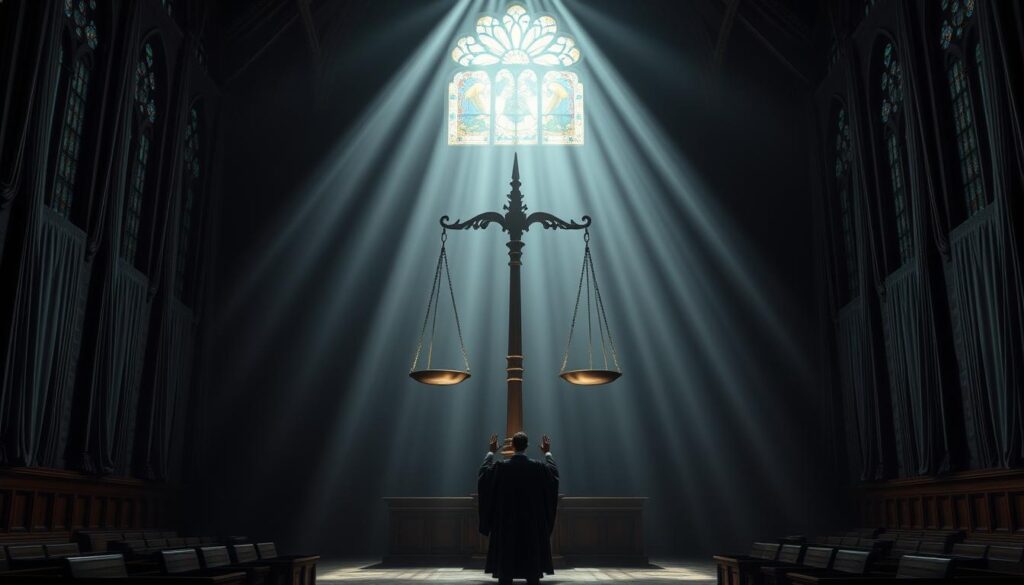
The table below shows the main differences in burden of proof between civil and criminal cases:
| Case Type | Burden of Proof | Standard |
|---|---|---|
| Civil | Preponderance of evidence | 51% certainty |
| Criminal | Beyond a reasonable doubt | 95% certainty |
Knowing the burden of proof in civil and criminal cases is vital. It helps us understand the legal system better. The different standards reflect the serious consequences of each case. Criminal cases need a higher burden of proof because of the harsher penalties.
Penalties and Remedies
In law, penalties and remedies are key in both civil and criminal law. Civil law aims to give remedies like money to the person who was wronged. Criminal law, on the other hand, punishes the wrongdoer with fines or jail time.
The Legal Aid Society of Northeastern New York explains the difference. Civil court judges can order money payments or fines. Criminal court judges can send someone to jail for breaking the law. The proof needed also varies, with civil cases needing more than half the evidence and criminal cases needing absolute proof.
The table below shows the main differences in penalties and remedies between civil and criminal law:
| Type of Law | Penalties | Remedies |
|---|---|---|
| Civil Law | Fines, monetary damages | Monetary compensation, injunctions |
| Criminal Law | Imprisonment, fines | Restitution, community service |
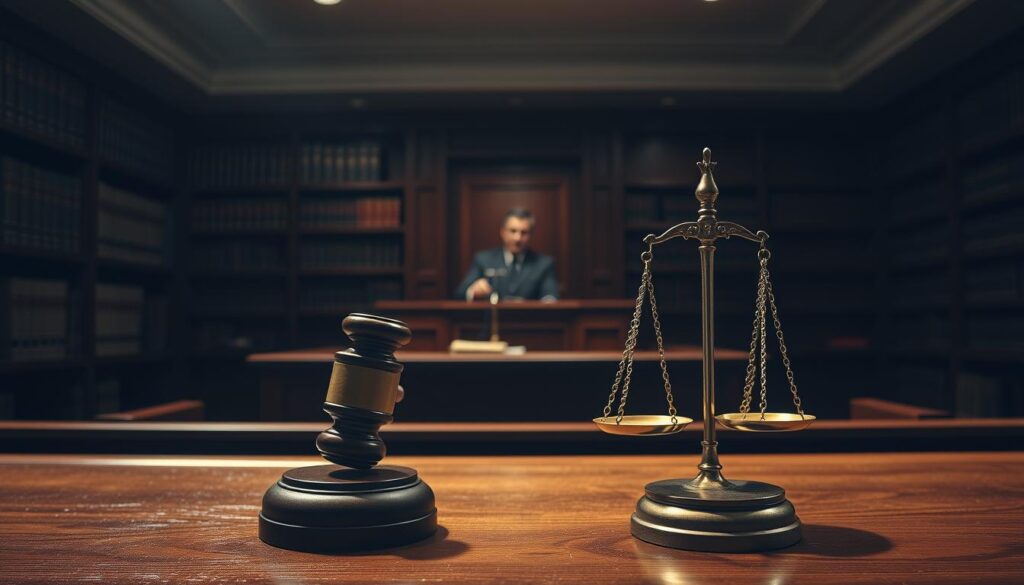
In conclusion, knowing the differences between penalties and remedies in civil and criminal law is vital. It helps us understand the legal system better. By knowing the goals and outcomes of each law, we can make better choices when seeking justice.
Role of Legal Representatives
Legal representatives are key in making sure justice is done. They include civil attorneys, criminal defense lawyers, and prosecutors. Their skills and law knowledge help them handle tough cases. They protect their clients’ rights and follow the law.
Civil attorneys deal with non-criminal cases like personal disputes. They give advice, write legal papers, and speak in court. Criminal defense lawyers defend people accused of crimes. Prosecutors, on the other hand, work for the state to prove someone’s guilt.
Civil Attorneys
Civil attorneys work on many types of cases, like personal injury or contract disputes. They need to be good at analyzing and talking to people. They also have to negotiate and fight for their clients’ rights.
The American Bar Association says civil attorneys must know the law well. This ensures their clients get fair treatment.
Criminal Defense Lawyers
Criminal defense lawyers must know the law and legal procedures well. They fight for their clients’ rights, dealing with complex issues. The Sixth Amendment guarantees the right to an attorney, which they uphold.
Prosecutors
Prosecutors work for the state, presenting evidence against defendants. They need to understand the law and communicate well with judges and juries. The National District Attorneys Association says prosecutors must seek justice while protecting the accused’s rights.

In summary, legal representatives like civil attorneys, criminal defense lawyers, and prosecutors are vital. Their skills and commitment to justice protect everyone’s rights and uphold the law.
Rights of the Accused
In the world of criminal law, the rights of the accused are key to a fair trial. The right to a fair trial is a core part of due process. This includes the right to legal help. If someone can’t afford a lawyer, they should tell the judge. The judge might give them a public defender or legal aid lawyer, as the Legal Aid Society of Northeastern New York says.
The importance of rights of the accused in criminal law is huge. It really affects the trial’s outcome. Some main rights include:
- The right to a fair and impartial trial
- The right to legal help, even if you can’t pay for it
- The right to due process, ensuring fair treatment during the trial
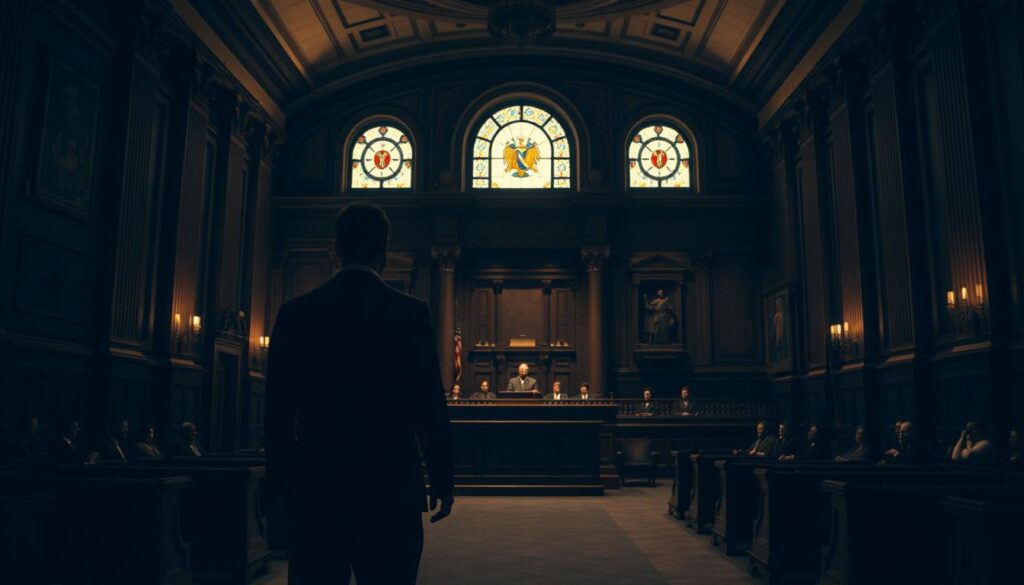
in a criminal trial is “beyond a reasonable doubt.” This is a higher standard than in civil trials. It shows how vital it is to protect the rights of the accused in criminal law. The penalties for a guilty verdict can be very harsh.
Following due process, the accused has the right to a fair trial. This includes the right to face witnesses and present their own evidence. This basic rule of criminal law makes sure the accused is treated fairly and justly. It also protects their rights during the trial.
Statute of Limitations
The statute of limitations is important in both civil and criminal cases. It sets a time frame for legal actions. In civil cases, the time limit varies by claim type. For example, in Texas, you have two years to file a medical malpractice claim.
In criminal cases, the time limits also change based on the crime. In California, many felony sex crimes no longer have a time limit. But, some crimes like those under Penal Code 261(a)(5) do. The time limit for most sex crimes in California can be extended by a year if DNA evidence is found.
Civil Case Time Limits
Civil case time limits are generally shorter. For example, debt collection time limits range from three to six years, depending on the state and debt type. In Florida, you have five years to file a debt claim after missing a payment.
Criminal Case Time Limits
Criminal case time limits are often longer. In California, misdemeanors have a one-year limit, while felonies have a three-year limit. Fraud cases have a four-year limit, and domestic violence cases have a five-year limit.

Knowing the statute of limitations is key in both civil and criminal cases. It greatly affects a case’s outcome. It’s important to understand the filing time limits and seek legal advice if unsure about your situation.
Impact on Society
The impact of civil law and criminal law on society is big. They shape social norms, economic stability, and individual rights. Civil law deals with issues like housing, family, and consumer problems. These issues affect many people and communities.
The Legal Aid Society of Northeastern New York says civil court cases have big effects. They affect not just the people in the case but also the whole community.
Criminal law cases have a deep impact on society. They deal with serious crimes that can lead to harsh penalties like prison and fines. A criminal conviction can limit a person’s future and cause long-term social and economic problems.
About 1 in 3 adults in the United States has a criminal record. This shows how criminal law affects many people in society.
Some important statistics about civil and criminal law’s impact include:
- 60% of criminal cases are resolved through plea bargaining
- 1 in 3 adults in the United States has a criminal record
- Civil disputes cover a wide range of issues, with contract disputes alone accounting for over 50% of civil litigation cases

The impact of civil and criminal law on society is complex. It involves the legal systems and the social and economic contexts they operate in. By understanding this impact, we can work towards a more just and equitable society for everyone.
| Type of Law | Impact on Society |
|---|---|
| Civil Law | Involves a variety of issues, including housing, family, and consumer problems |
| Criminal Law | Can result in significant penalties, such as imprisonment and fines |
International Perspectives
Looking at legal systems from international perspectives shows that countries have different ways of doing law. They use common law, civil law, and hybrid systems. Each has its own special traits and history.
Different legal systems are key, with some countries liking the flexibility of common law. Others prefer the clear rules of civil law. Hybrid systems mix both, aiming for a fair balance. Knowing these differences helps us understand law across the globe.
Common Law Systems
Common law systems, seen in places like the UK and the US, depend a lot on court decisions and customs. This makes law flexible and able to change.
Civil Law Systems
On the other hand, civil law systems, common in Europe, rely on detailed written laws. This system is clear and predictable, focusing on written rules.
Hybrid Systems
Hybrid systems mix common law and civil law elements. They offer a special mix that uses the best of both. These systems are found worldwide, showing the wide range of views on law.

Modern Challenges and Evolution
The legal world is always changing. Modern challenges include the use of technology and shifts in what society values. Legal systems must adapt to these changes to protect everyone’s rights.
Legal systems face big challenges today. These include cybercrime, the need for global crime-fighting efforts, and fixing racial gaps in justice. To meet these challenges, laws must evolve and use new technology and ideas.
Here are some ways laws are evolving to meet today’s challenges:
- More use of technology in courts, like online trials and digital evidence
- More focus on working together globally to fight crimes that cross borders
- Efforts to fix racial gaps in justice so everyone gets fair treatment

By embracing change and using new technology and ideas, laws can tackle today’s challenges. This way, justice can be served for everyone.
| Challenge | Solution |
|---|---|
| Cybercrime | Increased use of technology in legal proceedings, such as online courts and digital evidence |
| International cooperation | Greater emphasis on mutual assistance and cooperation in combating cross-border crimes |
| Racial disparities | More focus on addressing racial disparities and ensuring that justice is served for all individuals, regardless of their background |
Conclusion
Understanding the differences between civil and criminal law is key for everyone. Civil law handles disputes between individuals, aiming for financial solutions. On the other hand, criminal law focuses on crimes that harm society, with harsher penalties like jail time.
The legal systems worldwide aim to deliver justice. They use different standards of proof. Civil cases need only a majority of evidence, while criminal cases require proof beyond doubt.
Knowing the differences helps us make better choices and protect our rights. It’s essential for our communities’ well-being. This knowledge lets us interact with the legal system wisely and understand how justice is served.
FAQ
What is the definition of law?
Law is a set of rules that guide how people, groups, and societies act.
What are the main categories of law?
Law is divided into several types. These include civil law, criminal law, and more.
How have legal systems evolved historically?
Legal systems have changed over time. They’ve been shaped by ancient cultures, religions, and modern states.
What is the role of civil law?
Civil law helps solve disputes between people or groups. It deals with things like contracts and property.
What is the definition and scope of criminal law?
Criminal law punishes those who break the law. It aims to protect society and keep order.
What are the key differences between civil law and criminal law?
Civil law focuses on resolving disputes. Criminal law punishes lawbreakers. The proof needed is different too.
What are the common types of civil cases?
Civil cases often involve contracts, property, family, and torts. Each has its own rules and outcomes.
What are the common types of criminal offenses?
Criminal offenses range from serious felonies to minor infractions. Each has its own punishment.
What are the legal procedures in civil cases?
Civil cases start with a filing process. They then go through a discovery phase and may settle.
What are the legal procedures in criminal cases?
Criminal cases involve the prosecution, defense, and court. They ensure a fair trial and due process.
What are the burden of proof requirements in civil and criminal cases?
Civil cases need a “preponderance of evidence.” Criminal cases require “beyond a reasonable doubt.”
What are the penalties and remedies available in civil and criminal law?
Civil law can impose fines or compensation. Criminal law may include fines or jail time.
What are the roles of legal representatives in civil and criminal cases?
Civil cases have civil attorneys. Criminal cases have defense lawyers and prosecutors. Each has specific duties.
What are the rights of the accused in criminal law?
The accused have rights like due process and a fair trial. These ensure justice is served.
What are the statute of limitations in civil and criminal cases?
Statute of limitations set time limits for filing cases. They vary by case type and location.
How do civil and criminal law impact society?
These laws shape society’s norms and values. They also affect the economy and individual rights.
What are the common international perspectives on legal systems?
Legal systems worldwide are mainly common law, civil law, or hybrids. Each has its own features.
What are the modern challenges facing legal systems?
Legal systems face challenges like technology’s impact and changing values. They must adapt to a changing world.